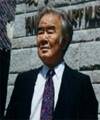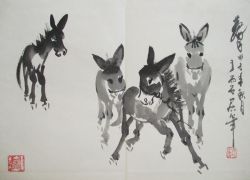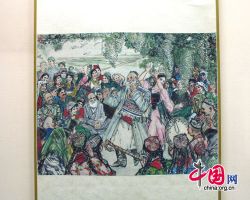Huang Zhou
Huang Zhou (Chinese:黄胄) was born in a poor village in Hebei Province in 1925, and died in 1997, having witnessed the development of new China. Unlike his predecessors such as Xu Beihong and Jiang Zhao, who had studied abroad and applied the precise anatomy approach to traditional Chinese painting, Huang learned from Chinese artists Zhao Wangyun and Han Leran, who added traditional Chinese cultural elements to painting. Shortly after Xi’an was liberated on May 20, 1949, Huang joined the People's Liberation Army to record the life and work of that period via paintbrush for a magazine.
Huang combined Western sketching skills and traditional Chinese painting to capture the movement of people and animals, which proved to be a huge success. His figure paintings depicted the vivid life scenes of Chinese ethnic groups and ordinary people, revealing a harmonious relationship between humans and nature. He led mainland Chinese painting to a new era.
According to Shi Guoliang, both Huang’s apprentice and a monk, diligence was what led Huang to success. He never stopped painting, even when he was seriously ill. His practice sketches could fill numerous burlap bags.
Huang worked hard after the Reform and Opening-up Movement in 1978, building several organizations such as the Academy of Chinese Painting and Yanhuang Art Museum to collect and show traditional Chinese paintings.



